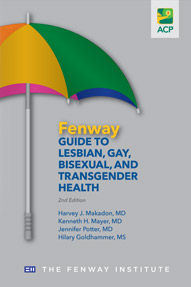Helping clinicians improve care for sexual, gender minorities
The second edition of “The Fenway Guide to Lesbian, Gay, Bisexual and Transgender Health” goes several steps further than its first edition by educating physicians on how to account for a changing cultural landscape.
The second edition of “The Fenway Guide to Lesbian, Gay, Bisexual, and Transgender Health,” published by the American College of Physicians, was written to help health care professionals attain a deeper understanding of sexual and gender minorities in an attempt to offer better and more sensitive care. It also goes several steps further, notably taking into account the evolving cultural landscape.

“Cultural shifts such as legalization of same-sex marriage and television shows such as ‘Transparent’ have done a lot to increase visibility and acceptance of LGBT populations,” said one of the book's authors, Jennifer Potter, MD, ACP Member. “But there is still a need for clinicians to recognize and address their own unconscious biases, since differences in sexual orientation and gender identity often challenge basic cultural and/or religious beliefs that are deeply ingrained. Learning how to provide sensitive and complete care to LGBT patients requires a level of introspection that tends to make health professionals better clinicians overall so they are able to be optimally effective with all of their patients.”
Authors Harvey J. Makadon, MD; Hilary Goldhammer, MS; Kenneth H. Mayer, MD, FACP; and Dr. Potter recently discussed the Fenway Guide with ACP Internist.
Q: How has the field changed since the previous edition of the book?
A: Dr. Makadon: Shortly after the first edition was published, the federal government came out with “Healthy People 2020” with recommendations on how to overcome disparities for LGBT people, and then the Institute of Medicine's report, “Health of Lesbian, Gay, Bisexual and Transgender People,” was released in 2011. Those 2 publications heightened awareness of disparities in the health of LGBT people, which were described in our book, but also cast a national spotlight on the need to focus on health equity for LGBT people in an era where there was a new emphasis on population health. In the ensuing years, there has been growing recognition of issues affecting LGBT people, and there has been much more awareness of, and the need to provide care for, transgender people, leading us to write this new edition.
Q: What did you cover in this edition that was not covered the last time?
A: Ms. Goldhammer: Since the publication of the first edition, there have been changes in the way that providers care for transgender patients, including new standards of care, as well as new approaches to creating health care systems that successfully capture gender identity that are affirming for transgender patients. All of these changes are covered in detail in our chapters on transgender adult health. We also added a chapter on gender identity development in children and adolescents, which explains how primary care providers can support gender-nonconforming and gender-discordant youth and their families. Chapters on HIV prevention [and] global LGBT health, as well as how intersecting identities—e.g., sexual, gender, racial, and economic—can affect engagement with health care providers, have also been added.
Q: What is the need for a book like this for primary care physicians?
A: Dr. Makadon: When we ask medical students how much they learn about issues relevant to treating LGBT patients, the answer is typically “almost nothing.” When we ask people what they are asked about their sexual history, most say their doctors do not address that or their sexual orientation or gender identity. These are among the factors supporting a hypothesis that the LGBT population does not seek out health care or return for follow-ups to the same extent as the general population. Because of this, as examples, routine Pap smears and prostate exams are not done, and as a result there are disparities in the treatment of LGBT people. For instance, lesbian and bisexual women tend not to get cervical exams or mammograms to the extent of the general population, and in the transgender population, where one's anatomy isn't necessarily predictable, physicians don't order appropriate tests because they don't ask appropriate questions.
A lot of what we focus on in the book is how to ask appropriate questions, ranging from how to discuss sexual behavior and risk of HIV and [sexually transmitted infections] and how to learn about gender identity and if someone has affirmed their gender different than what they were assigned at birth and what kind of treatment they've had that affects the kind of care they need.
Q: How can physicians and staff make LGBT patients feel at ease?
A: Dr. Potter: The first thing is to signal a welcome before a patient even gets to the office by listing providers in LGBT directories, posting nondiscrimination policies inclusive of sexual orientation and gender identity on websites, and training phone staff to expect people with all sexual orientations and gender identities. For example, when registering new patients, staff need to be careful not to make assumptions about a person's gender by the timbre of their voice or about the gender of a person's spouse or partner. These general tenets must continue on arrival to the office, with patient education pamphlets that are inclusive of people of all sexual orientations and gender identities, forms that include questions about sexual orientation and gender identity, medical records that can document preferred name and pronouns, and sensitive staff.
Providers have a responsibility to role model desired behavior for staff by demonstrating acceptance, asking open-ended questions that are inclusive of people of any sexual orientation or gender identity, and, for transgender patients, remembering to use a person's preferred name and pronouns throughout an encounter.
Q: How can physicians work to be more inclusive in their health histories/exams?
A: Dr. Potter: It's important to create a trusting relationship where a patient feels safe disclosing information and to know what information is particularly important to ask. For example, since many LGBT people, especially people on the transgender spectrum, have experienced stigma, discrimination, and even hate crimes, it is important to screen for a history of abuse. With respect to physical exams, providers should carefully explain why they want to do a particular exam, obtain express consent and agree on how to proceed so as to make the exam most comfortable, and be ready to stop the exam immediately, if requested by the patient.
Q: What medical issues do you see as most pressing for LGBT patients in primary care?
A: Dr. Mayer: In terms of medical issues, we certainly still have an HIV epidemic in the U.S., where 1 out of 5 HIV-infected Americans are unaware of their infection. Many of those undiagnosed individuals access health care but may not be tested for HIV because they are not comfortable disclosing personal information to their physicians. Primary care providers have a key role here in asking appropriate questions and testing people for HIV and other sexually transmitted infections. Screening for infectious diseases is very important, and knowing how to provide appropriate vaccinations for people who may benefit from them is an important area, as well.
Q: How can physicians better serve their LGBT patients?
A: Dr. Mayer: Creating a supportive environment is crucial to helping patients feel comfortable disclosing sensitive information so that the health care provider can make important clinical decisions. If the patient is not comfortable sharing that he has engaged in anal intercourse, for example, then the provider won't screen for rectal sexually transmitted diseases. Getting over the “Don't ask, don't tell” mentality, and moving to a “Do ask, do tell” mentality where our patients are our partners in decision making, is crucial to achieving health equity for LGBT people.



